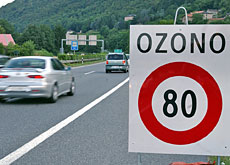Environment lobbyists face exhausting fight

Stinking exhaust fumes hanging in the air of Swiss cities may become a thing of the past if a move to ban polluting vehicles from town centres gets the go ahead.
But not everyone is convinced that the establishment of so-called low-emission zones (Lez) will contribute much to lowering the concentration of dangerous fine particles, which can lead to bronchial disease.
The permitted limits for these particles in the air are regularly exceeded in Switzerland’s larger towns, especially in winter. One source is diesel engines without filters.
To combat the problem, a number of European cities have introduced Lez – also known as environment zones – in the past few years. All vehicles entering the zones must meet certain emission standards.
The city of Geneva and the canton of Ticino are the prime movers in getting the system introduced to Switzerland.
The Federal Environment Office has now drawn up a draft decree on the issue and sent it to interested parties – towns, cantons, political parties, and the relevant associations – for their comments. These are to be submitted by November 26.
The cabinet will then take a decision on the matter.
Stickers system
Under the proposals, only “clean“ vehicles would be allowed into city centres. The size is irrelevant, but the technology of their engines must be up to date.
Depending on the emissions it produces, a vehicle will be awarded a red, orange or green sticker. Vehicles without stickers may not enter the Lez.
It is not yet clear how much the stickers will cost and what categories of vehicle will be allowed into the zones at what time. It is up to the communes and cantons to decide on the specific details.
But the central government is responsible for establishing the fines for violations of the rules. Putting a sticker on the wrong vehicle will incur a fine of SFr500 ($493) and entering a zone without a sticker will cost SFr100.
Experience abroad
But Switzerland cannot simply take over foreign models, Antonello Lavegliat, spokesman for the Federal Roads Office, told swissinfo.ch.
“There are different conditions in every city, and a wide range of differences. “
He added that no clear conclusions can yet be drawn from the German experience.
The European Union-supported website Low Emission Zones in Europe states that between January 2008 and April 2009 the concentration of the very finest particles – so-called PM10 – in Berlin fell by eight per cent, and that emissions of diesel particulates were reduced by 24 per cent.
But a thorough study conducted in Germany by the ADAC automobile club, a motorists‘ lobby group, concluded that the establishment of Lez had not brought any “demonstrable improvement“ in the towns concerned.
The study compared air quality in pairs of similar towns, one with a Lez and the other without.
One of its findings was that even on heavily used main streets only about nine per cent of the fine particles came from traffic.
The ADAC says that the Lez are too small to make a difference, and points out that the concentration of fine particles depends to some extent on weather conditions.
In the case of Berlin, for example, the air quality is affected by wind-borne particles from antiquated power stations in Poland: even if everyone in the city walked, the levels would still be too high, the ADAC claims.
Debate in Switzerland
The Touring Club Switzerland (TCS) – the Swiss equivalent of the ADAC – also has its doubts about the usefulness of such zones.
The effort and expense of administering and monitoring them would be much too high in comparison with the benefits to the environment, according to TCS spokesman Stephan Müller.
“Progress in exhaust technology means that vehicles no longer represent a problem,“ he claims. Instead of environment zones the TCS wants to see more high-rise parking on the outskirts of cities, and larger pedestrianised areas.
On the other hand the Swiss Association for Transport and Environment has been campaigning for Lez for years.
”They will certainly help in towns and urban agglomerations,” said spokesman Gerhard Tubandt.
While admitting that there had so far been no reliable studies, he said that such zones were just one way to decrease emissions, and that a speed restriction of 100 kilometres per hour on motorways near built-up areas would be another.
He foresees “tough struggles” ahead politically, but welcomes the fact that the idea is on the table.
“The main thing is that the cantons should be given the chance to introduce such zones if they want to.”
Andreas Keiser, swissinfo.ch (Adapted from German by Julia Slater)
Fine particles, known as PM10 (particulate matter, smaller than 10 thousandths of a millimeter, or one micrometer), are believed not only to have an impact on health but also to affect the climate.
They can cause chronic coughing, bronchitis, asthma, lung cancer, and circulatory problems, including heart attacks.
They come from a variety of sources: factory emissions, exhaust from road and rail traffic and from farm and construction machinery.
Furthermore, vehicles not only produce exhaust fumes, they also stir up particles into the air.
Many particles reflect solar radiation back into space which may lead to a local cooling of the atmosphere. Others, however, behave in the opposite way, absorbing light and warming the atmosphere.
Air pollution kills an estimated 310 000 people a year in Europe.
The EU has set legally defined air quality standards, but many cities fail to meet them.
“Low Emission Zones” (Lez), or “Environment Zones” are designed to help bring pollution down.
Entry to a Lez is restricted for vehicles with high pollution engines.
There are currently over 160 Lez in 11 countries in Europe, including Berlin, Amsterdam, London and Milan.
Current Lez in Europe
Austria: 2
Czech Republic: 1
Denmark: 5
Germany: 43
Hungary: 1
Italy: 84
The Netherlands: 11
Norway: 3
Sweden: 5
United Kingdom: 3 (London, Norwich, Oxford)
(Adapted from German by Julia Slater)

In compliance with the JTI standards
More: SWI swissinfo.ch certified by the Journalism Trust Initiative












You can find an overview of ongoing debates with our journalists here . Please join us!
If you want to start a conversation about a topic raised in this article or want to report factual errors, email us at english@swissinfo.ch.